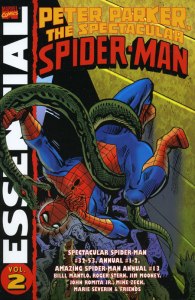First Published: October 2005
Contents: Marvel Spotlight #5 (August 1972) to #12 (October 1973); Ghost Rider #1 (September 1973) to #20 (October 1976); and Daredevil #138 (October 1976)
Key Creator Credits: Roy Thomas, Gary Friedrich, Mike Ploog, Tom Sutton, Tony Isabella, Jim Mooney, George Tuska, Frank Robbins, Marv Wolfman, John Byrne, and others
Key First Appearances: Johnny Blaze/Ghost Rider, Roxanne Simpson/Katy Milner, Crash Simpson, Daimon Hellstrom/Son of Satan
Story Continues In: Essential Ghost Rider Vol. 2
Overview: Johnny Blaze is a motorcycle daredevil with a traveling road show. When the owner of the show, Crash Simpson, announces he is dying from cancer, Blaze seeks out and strikes a deal with Devil for his soul in an attempt to save Crash. The Devil accepts, but like any deal with Satan, the deal works against Blaze. Crash is saved from cancer but still dies in a stunt accident. As part of his deal, Johnny Blaze is transformed into a mystical servant of Hell, known as the Ghost Rider.
The early stories deal with Blaze trying to free his soul from the control of Satan. This leads to the introduction of the devil’s estranged offspring, Daimon Hellstrom, who would become an anti-hero in his own right as the Son of Satan.
Eventually, Blaze gets his soul released, but he still retains the Ghost Rider abilities. Early on, his transformations occurred at dusk, but now Blaze finds that he can now control the transition for anytime day or night. He can also extend his powers to create a flaming motorcycle out of the hellfire at his control.
In the later issues, Blaze starts working in Hollywood as a stuntman on a television show, where he meets the actress Karen Page. For longtime Marvel readers, you will recall Page as the one-time secretary of lawyer Matt Murdock. So it’s only natural that Ghost Rider would cross paths with Daredevil, the man without fear, which is exactly what happens as this volume concludes.
What makes this Essential?: I will be the first to admit that I have never been a Ghost Rider fan. I held off getting this book for as long as I possibly could, just out my general dislike for the character. What I found reading the early stories of Johnny Blaze is a far different Ghost Rider than the one that gained such popularity in the 1990s. This Ghost Rider seems more human, whose initial changes were brought on by the setting and rising of the sun. He’s a true anti-hero, never viewing himself as a super-hero; just much more interested in riding his bike at the next show. Based on his history in the Marvel Universe, the Ghost Rider is an important hero to read. But the Ghost Rider in these stories is much different than the Ghost Rider you picture in your head.
Footnotes: Marvel Spotlight #12, and Ghost Rider #1 & #2 are also reprinted in Essential Marvel Horror Vol. 1.
Ghost Rider #10 is a reprint of Marvel Spotlight #5. The cover to Ghost Rider #10 is included in this volume. In the letter column in Ghost Rider #11, it was revealed that the cover for issue #10 went to press before Marvel realized that the issue would not be ready in time.
Ghost Rider #19 & #20, and Daredevil #138 are also reprinted in Essential Daredevil Vol. 6.
There are two early Ghost Rider appearances that are not collected in this volume, but they can be found in other Essential volumes. Marvel Team-Up #15 (November 1973) can be found in Essential Marvel Team-Up Vol. 1, and Marvel Two-in-One #8 (March 1975) can be found in Essential Marvel Two-in-One Vol. 1. In my opinion, both should have been included, given the number of references to those stories in the Ghost Rider title. In particular, the Marvel Team-Up issue features the first appearance of The Orb, who returns as a foe in Ghost Rider #14 and #15.
If you like this volume, try: Marvel’s first team of heroes in California, The Champions. Created by Tony Isabella to feature Angel, Iceman, and Black Goliath, it was retooled without Black Goliath and with the additions of Black Widow, Hercules, and Ghost Rider. Given the diverse line-up of the team, there were a lot of wild adventures during the team’s all-too-short 17 issue run. The Champions #1 (October 1975) debuted during the period covered in this Essential Ghost Rider, and several issues make references to his adventures with the team. While the entire series is collected in two Classic volumes, this is a series that shows up frequently in back issue bins. Make a point to track this series down!











